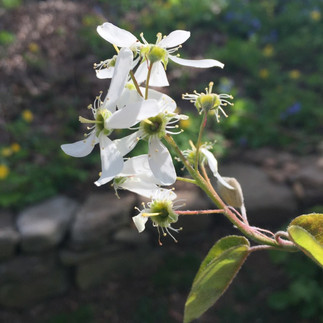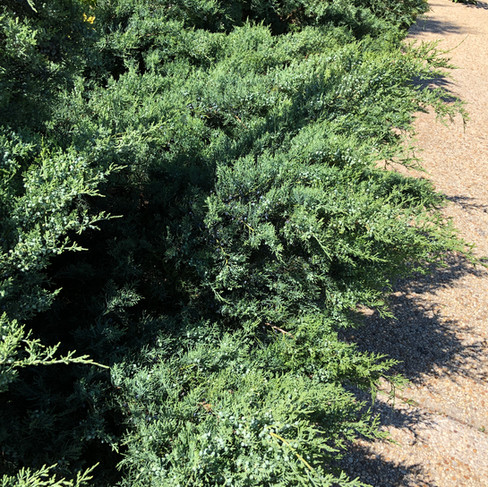The evergreen that does it all.

Eastern red cedar (Juniperis virginiana) is an iconic native evergreen growing to heights of 30 to 60 feet. Magical in the number of eco-benefits it provides, it's also a multi-tasker, serving as a specimen tree or in a group as a screen, hedge or wind break.
Eastern red cedar grows easily in clay, dry and wet soils (though it can't grow in consistently wet soils.) The Missouri Botanical Garden says it has the best drought resistance of any conifer native to the eastern U.S. They thrive in full sun and grow in part sun too.
In the garden, eastern red cedar adds something for every season. The trees are hubs for song bird activity on cold winter days and hot summer days alike. The blue berries on female trees are irresistible to cedar waxwings, dark eyed juncos and robins.

In a snowfall, the eastern red cedar is magnificent. Graceful draping boughs add shade in the heat of summer as well.

When we moved into our row home on a 1/8 of an acre lot, we were lucky enough to inherit a row of mature eastern red cedars planted very closely together, probably intended as a screen. In our small space, they provide needed screening, bird habitat and graceful shapes. They really make the garden.

I have limbed a few up a bit and underplanted with oak leaf hydrangeas (Hydrangea quercifolia), bayberry shrubs (Morella pennsylvanica) and heuchera 'Autumn Bride' (Heuchera villosa 'Autumn Bride'). I never would have thought to plant multiple eastern red cedars within several feet of each other but I am so glad somebody did. It reminds me of something native plant advocate and entomologist Dr. Doug Tallamy says. "We can have many more trees in our gardens than we think we can."

We have added several more smaller cultivars of eastern red cedars since moving in. The mature trees also produce a couple of volunteer seedlings each year which can be transplanted to another location or grown on in containers.
There is one very slight downside to these trees. Eastern red cedars host cedar apple rust (there is also cedar hawthorn and cedar quince rust). A rust gall forms on the eastern red cedar and eventually releases spores. Spores travel by breezes to trees in the apple family producing "rust" on the fruits. I had read about this but never seen it in action. Shortly after moving here, we planted four serviceberry and hawthorn trees (both in the apple family) near the eastern red cedars. After the serviceberries bloom, the flowers produce small red fruits in early summer. The rust looks like orange fuzz on those fruits. It does not seem to affect the birds' desire to eat the fruits. On hawthorn trees, which produce fruit in fall, the fruit is untouched though some of the leaves get a bit of that "rust." So if you have apple trees, crab apples, serviceberries, hawthorns or others in the apple family, Extension Services recommend planting them at least 500' away from the eastern red cedar to avoid cedar rust. Cedar rust rarely kills trees. To me, it doesn't really matter. The attributes of the spring fruiting serviceberries and the fall fruiting hawthorns far outweigh the downsides of the rust. For information about this from an expert, click here.
Smaller Cultivars
What to do if you don't have room for a 40 foot tall eastern red cedar tree? There is much good news. A number of smaller cultivars with many of the same attributes of the straight species are available and several are described as rust resistant if that is a concern. Here are some of the cultivars more commonly available.

Taylor red cedar (Juniperis virginiana 'Taylor')
This is a shorter, narrower eastern red cedar growing to 20 feet tall but only 4 feet wide. If you are looking for a vertical element in your garden, this could be it. Like the straight species, you will find male and female trees with the females having the blue berries. Experts say in drier conditions the foliage will have a bluer cast. I do not have experience growing this. If you do, please kindly share in the comments below.
Eastern red cedar 'Emerald Sentinel' (Juniperis virginiana 'Emerald Sentinel')
This is a female cultivar so always has the blue berries. It's somewhat smaller than the straight species growing to 25 feet tall and 8 feet wide. I bought the Emerald Sentinel cultivar two years ago at a local garden center. I initially grew it in a container and recently planted it in the ground in part shade. Eastern red cedars thrive in full sun but are said to be able to grow anywhere but full shade. I am keeping a close eye on it in case I need to move it to a sunnier location.

Eastern red cedar 'Burkii' (Juniperus virginiana 'Burkii')
This is a shorter cultivar which grows 10 to 15 feet tall and up to 10 feet wide. This cultivar has a blue tint to the foliage and is always a male so will not have berries. This cultivar is also said by experts to have good resistance to cedar-apple rust. I am growing this but they are relatively new to me.
Eastern red cedar ‘Grey Owl’ (Juniperus virginiana 'Grey Owl')
This is a low growing cultivar that grows to be 3 feet high and about 6 feet wide. It has a silver blue color. Plants are male or female with the female having the blue berries. It is reported to be slow growing and would be perfect for a smaller sunny garden. This cultivar also has good resistance to cedar apple rust.

Eastern red cedar 'Blue Arrow' (Juniperus virginiana 'Blue Arrow')
This is a narrow blue cultivar of the eastern red cedar said to grow well in sun or part shade. It grows to 15 feet tall and 4 feet wide. It would make a great substitute for the Colorado spruce if you were looking to add blue to your garden. One note, some nurseries also sell a blue cultivar of the rocky mountain juniper (Juniperus scopularum) so those would not be native to the Chesapeake. This is where googling those latin names comes in handy.
Where to Get Trees
Native plant nurseries and garden centers often have small straight species eastern red cedar trees and the eastern red cedar 'Grey Owl' juniper. Kollar Nursery also has the 'grey owl.' Other cultivars can be a bit harder to find but they are definitely available. Herring Run Nursery in Baltimore typically carries the straight species but will work with you to find out if their growers have the cultivar you are looking for. I purchased our Eastern red cedar 'Emerald Sentinel' at Merrifield Garden Center in northern Virginia. They will also special order specific trees for you through their evergreen desk. American Plant in Bethesda carries the eastern red cedar "Burkii" from time to time and will also special order for you. Unity Church Hill Nursery on Maryland's eastern shore carried several of the eastern red cedar cultivars this summer and still has the straight species and two other cultivars not discussed above named "Brodie' and "Emerald Feather." The photo of the Eastern red cedar "Taylor" cultivar above was taken at Homestead Gardens in Davidsonville who will also special order for you.
Eastern red cedar is majestic, magical and a multi-tasker. And I didn't even mention the bark. Thank you for gardening for the Chesapeake!































Comments